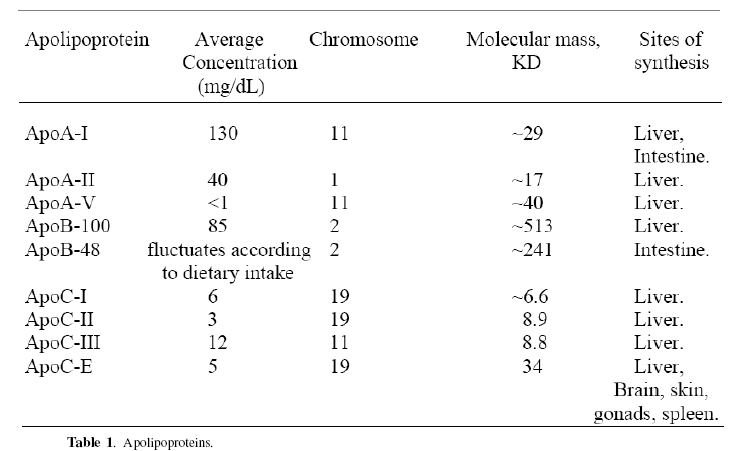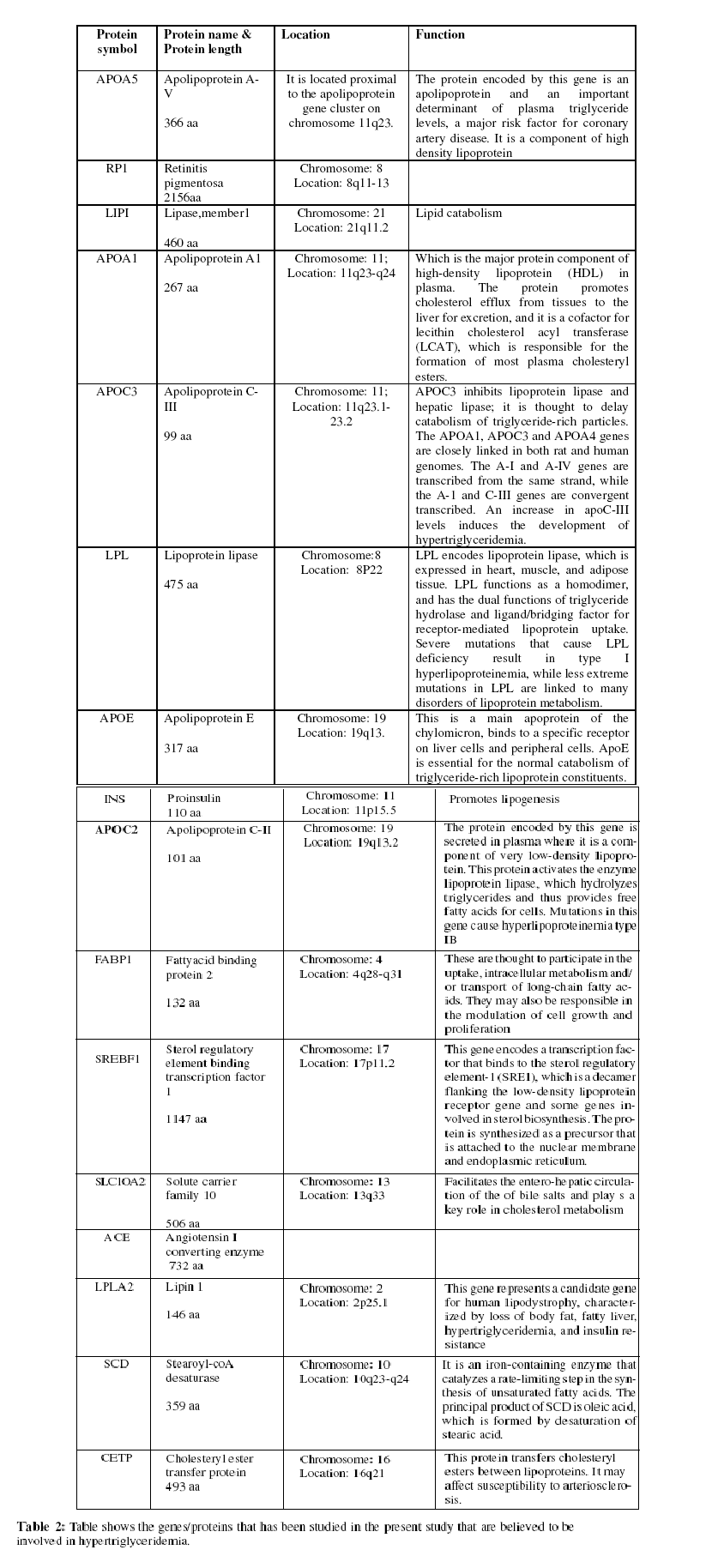Journal of Proteomics & Bioinformatics
Open Access
ISSN: 0974-276X
ISSN: 0974-276X
Research Article - (2008) Volume 1, Issue 2
Hypertriglyceridemia is defined as an abnormal concentration of triglycerides in blood and is a commonly encountered lipid abnormality frequently associated with other lipid and metabolic derangements. Prolonged hypertriglyceridemia may produce neuropathological and abnormal metabolic changes particularly in peripheral sensory nerves. In the present study, we evaluated the role of several proteins that are likely to be involved in hypertriglyceridemia by employing multiple sequence alignment using ClustalW tool and constructed a phylogenic tree using functional protein sequences extracted from NCBI. The phylogeny tree was constructed with Neighbor Joining Algorithm using bioinformatic principles and applications. The association of apolipoprotein C-II, proinsulin, fatty acid binding protein, sterol regulatory element binding transcription factor, angiotensin I converting enzyme, lipin 1, sterile co-A desaturase, cholesteryl ester transfer protein, and other apolipoproteins in hypertriglyceridemia suggests that a close interaction between these proteins may exist that may underlie the pathogenesis of hypertriglyceridemia. The results of the present bioinformatics study indicate a predominant involvement of apolipoprotein C-II, proinsulin in comparison to other proteins in the pathogenesis of hypertriglyceridemia.
Keywords: Hypertriglyceridemia, Apolipoprotein C-II, Proinsulin, Bioinformatic analysis
The two main sources of plasma triglycerides (also known as triacylglycerol) are exogenous (i.e., from dietary fat) and carried in chylomicrons, and endogenous (from the liver) and carried in very low-density lipoprotein (VLDL) particles. In capillaries within fat and muscle tissue, these lipoproteins and chylomicrons are hydrolyzed by lipoprotein lipase into free fatty acids. After a meal, over 90% of the circulating triglycerides originate in the intestine and are secreted in chylomicrons, whereas during periods of fasting, endogenous triglycerides secreted by the liver as VLDL predominate. The increase in plasma of triglyceride-rich proteins results from the liver and intestine (by means of upregulated synthetic and secondary pathways) or through decreased peripheral catabolism (mainly from reduced lipoprotein lipase activity)(George et al., 2007).
Lipoproteins are macromolecular assemblies that contain lipids and proteins. The lipid constituents include free and esterified cholesterol, triglycerides and phospholipids. Apolipoproteins also known as apoproteins provide structural stability to the lipoproteins and also may function as ligands in lipoprotein receptor interactions or as cofactors in enzymatic processes that regulate lipoprotein metabolism. Table 1 (Goodman and Gilman, 2006) describes apolipoprotein that have well defined roles in plasma lipoprotein metabolism. The lipoproteins were discovered by separation of the proteins after delipidation of plasma lipoproteins - initially classified as apolipoprotein A if present in alpha-lipoproteins (HDL), apolipoprotein B if present in beta-lipoproteins (LDL) and apolipoprotein C if present in prebeta- lipoprotein (VLDL) (Fredrickson, 1974). Following further protein purification, sequencing, and genomic studies, these were reclassified and the major apolipoproteins affecting lipoprotein metabolism, apolipoproteins A1, A2, A4, B100, B48, C1, C2, C3 and E, were identified (Li and Chan, 1999).

Diabetes Mellitus Association with Hypertriglyceridemia
Diabetes mellitus is estimated to affect 6% of the population and DM2 accounts for 90–95% of diabetes cases (75). FFA act as incretins, that is, augment glucose stimulated insulin secretion, which is important under physiological conditions. However, FFA alone is not secretagogues. A two-arm signalling pathway is proposed to trigger secretion of insulin. The first arm is associated with acetyl-CoA mediated ATP/ADP ratio increase, which closes ATP-sensitive K+ channels, thereby depolarizing the cell. The consequence is the prolonged open-time of voltagedependent Ca-channels. Finally the elevated intracellular Ca2+ concentration modulates kinases and other signalling proteins managing insulin secretion. The activity of the second arm is associated with pyruvate synthesis from glucose, followed by oxaloacetate and citrate production which is responsible for the subsequent malonyl-CoA synthesis. The latter is a switch repressingâ-oxidation and stimulating synthesis of long-chain- CoA (LCCoA) and complex lipids — diacylglycerols and phosphatidate. FFA is implicated by being a direct substrate for LC-CoA synthesis. Short term exposure to high FFA plasma concentrations has been proved to augment glucose-stimulated insulin secretion, while long-term oversupply with FFA increases basal insulin secretion and exacerbates glucose-dependent secretion. Lewis et al., (1991) reported that moderate fasting hypertriglyceridemia in non insulin dependent diabetes mellitus predictive of a constellation of postprandial changes in lipids and lipoproteins that may potentiate the already unfavorable atherogenic fasting lipid profile.
Experimental Protocol and Results
The present research aims at finding the proteins responsible for hypertriglyceridemia in two phases. The first phase of the research attempts to identify the candidate proteins that cause hypertriglyceridemia. The data pertaining to these proteins is extracted from the databases that are available online for free access. The functional protein sequences of these proteins in FASTA are to be extracted from (National Center for Biotechnology Information (NCBI), (http://www.ncbi.nlm.nih.gov/).
The second phase of the research analyzes the data by employing Multiple Sequence Alignment using ClustalW online tool. These alignments produce a Phylogenetic Tree along with the alignment scores. From the tree the results of the research are to be inferred in the last phase of the research.
ClustalW, a web based progressive alignment tool for Multiple Sequence Alignment (MSA). ClustalW adds sequences one by one to the existing alignment to build a new alignment because of its progressive nature. Progressive in this context means, it starts with using pair wise method to determine the most related sequences and then progressively adding less related sequences initial alignment. The order of the sequences to be added to the new alignment is indicated by a precomputed phylogenetic tree called a guide tree. The guide tree is constructed using the similarity of all possible pairs of sequences The functional protein sequences of 16 proteins that are believed to be involved in the pathogenesis of diabetic neuropathy collected from NCBI (National Center for Biotechnology Information http://www.ncbi.nlm.nih.gov/) in FASTA forms (these sequences are given to clustalw http://www.ebi.ac.uk/clustalw) were analyzed for the multiple sequence alignment (it calculates that the best match for the selected sequences, and lines them up so that the identities, similarities and differences can be seen) and the resultant score the phylogeny tree constructed based on these results are given in Table 2 and Figure 1 respectively. The phylogeny shows the distance between the protein sequences. The protein sequences with minimum distance are apolipoprotein C-II and proinsulin, which suggests that these proteins play a significant role in the pathogenesis of hypertriglyceridemia.

Hypertriglyceridemia is common in Indians. However, the exact cause for this high incidence has never been adequately explained. Although Indians as a race may have a higher risk to develop various features of metabolic syndrome, what are these genetic factor(s) has never been elucidated. One suggestion that has been made is the thrifty gene hypothesis. It was postulated the existence of metabolically thrifty genes that permit efficient utilization of food leading to fat deposition and weight gain at times of food abundance making the gene-bearer better able to survive during times of famine. Examples of thrifty genes included insulin and leptin. Nondiabetic Nauruans and Arizona. Pima Indians have postprandial levels of plasma proinsulin that are almost triple those of Europeans. These populations when given ample food first develop hypertriglyceridemia and then develop obesity, a propensity that they exhibit more compared to Europeans. Experimental rats carrying genes predisposing them to hypertriglyceridemia and obesity survive starvation better than do normal rats. In addition to the genetic component, hypertriglyceridemia and metabolic syndrome also involves environmental and lifestyle risk factors in the form of high calorie intake and low exercise (Figure 2).
Recently JogiRaju et al., (2007) reported the hyper filtration with metabolic syndrome in relation to hypertriglyceridemia. Apolipoprotein A5 (APOA5) is a newly described member of the apolipoprotein gene family whose initial discovery arose from comparative sequence analysis of the mammalian APOA1/C3/A4 gene cluster. Studies in humans have suggested an important role for APOA5 in determining plasma triglyceride concentrations (Len and Edward, 2003). In these experiments, polymorphisms in the human gene were found to define several common haplotypes that were associated with significant changes in triglyceride concentrations in multiple populations. Tsutomu and Masa –aki, (2005) have prioritized the significance of 6131 well-annotated human genes in terms of the distance on the plane from the centroid of ‘metabolic syndrome’ related genes distribution according to them a methodology to search for genes associated with multifactorial diseases by integrating the large amount of accumulated knowledge is seriously needed.
Proinsulin has anti-inflammatory actions. Proinsulin suppresses the production of TNF-alpha, IL-6, IL-1, IL-2, and macrophage migration inhibitory factor (MIF), which are proinflammatory molecules and enhances the production of IL-4 and IL-10 that are anti-inflammatory cytokines. This suggests that the presence and purpose of hyperinsulinemia in normal Indians is to prevent or abrogate the low-grade systemic inflammation that is inherent in them as evidenced by elevated levels of CRP, and possibly, TNF-alpha and IL-6. On the other hand, leptin has pro-inflammatory actions. Since hyperinsulinemia and hypertriglyceridemia are evident in Indian children compared white children, it is clear that features of low-grade systemic inflammation and metabolic syndrome are initiated very early in life.
Bioinformatics analysis of functional protein sequences of genes and related proteins that are involved in hypertriglyceridemia revealed a high degree of homology between apolipoprotein C-II and proinsulin. It is evident from the preceding discussion and results of the present bioinformatics study that apolipoprotein C-II and proinsulin play a significant role in the pathobiology of hypertriglyceridemia.